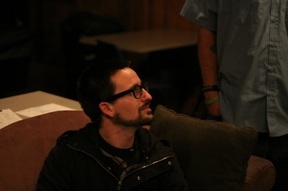Carpe Noctem Chapbook Interview With Larry Eby
 ELJ Publications THINGS WE’RE DYING TO KNOW…
ELJ Publications THINGS WE’RE DYING TO KNOW…Let’s start with the book’s title and your cover image. How did you choose each? And, if I asked you to describe or sum up your book, what three words immediately come to mind?
The title Machinist in the Snow was part of a small chapbook project with a friend of mine, Aaron Reeder. I’m not exactly sure where it came from, but usually I come up with the titles of projects first, then I try to figure out what they are about. This just sounded right at the time. Aaron and I went to school together at Cal State, San Bernardino, and one summer we decided we wanted to put together a collaborative chapbook. So we decided to come up with two different project titles, write 10 poems to each, and put them together to see how they melded. His was Bathing in Antlers, so there was definitely an eco-theme going on. I think, ultimately, my title came from my obsession with how the industrial complex interacts with the world.
The cover art is by an artist named Justin Witmer, who I also met during my time at Cal State, San Bernardino. He had posted some recent album covers that he had done for some death metal bands, and the art really matched up with what I was going for. It’s dark, surreal, and sparse, feelings that relate to the book’s content.
What were you trying to achieve with your book? Tell us about the world you were trying to create, and who lives in it.
Although I didn’t have a goal starting out, I think the book eventually revealed its goals during the process of writing it. Poetry is an act of unification. It seizes whatever it can and combines it, revealing something new. I think this project attempts at reconciling the two major forces of human activity and nature’s push to sustain itself. I don’t necessarily think this is a binary, since human activity is, in a sense, natural, but there seems to be a generally accepted idea that it is somehow separate.
I’m not sure I could claim the title of epic, but the book is a long poem with one narrative arc. In it, a machinist self-exiles into a frozen, wasteland. He’s mostly observer in the beginning, but becomes entwined in it, learning as the narrative progresses that he is there to restore it. It is, in a sense, a hero’s journey. Structurally, there are a lot of commonalities. This wasn’t necessarily the goal, but it’s definitely something I’m interested in, so I’m not surprised it ended up in the book.
The machinist is this sort of pseudo-tech, old world blend of historical innovation and modern innovation. He’s, ultimately, outside of any era. Once he passes the threshold into the world, he’s no longer in any specific time, but all of them at once. So the language attempts to mirror that. There’s a lot of cogs and computer language. There’s a lot of memory of a world that may or may not have existed yet.
Can you describe your writing practice or process for this collection? Do you have a favorite revision strategy?
I wrote this book fairly quickly over the course of a couple months. I’m all for the quick draft, since once you have an idea, it’s important to keep the tone of that idea similar. Because of technology and social media, our vocabularies change rapidly and this can mess with consistency. Something I may write today, I wouldn’t dare write the next, so I try to get everything down while I’m in that mode.
Editing is a bit different. I try not to tweak too much of what comes out the first time around. But I did end up rewriting this book (mostly copying from one document to the other) in one afternoon to make sure there weren’t any moments that didn’t match the overall feel. There was a lot of rewriting and structure changes. Originally, the book had quite a lot of formal forms in it. I only kept two of the formal structures during that rewrite. There is a villanelle, that is slightly modified, and a perfect haiku hidden in the middle of a free verse poem. There used to be a formal pantoum, but now it’s only a fragment of what it used to be.
How did you order the poems in the collection? Do you have a specific method for arranging your poems or is it sort of haphazard, like you lay the pages out on the floor and see what order you pick them back up in?
Since this is a narrative poem, it took a lot of rearranging for me to actually find what that narrative was. I wrote it in fragments and it used to be ordered by numbered sections. But once I started to see that there was a narrative, I had to find a way to rearrange it. I tried my old process of taping everything to a wall and rearranging it, but it didn’t quite work out. I ended up using 3x5 cards with the first and last lines of the sections, and a note about where the machinist was physically in the poem. Was he in the forest? On the highway? Leaving home? In a cave? And so on. Once I had that organized, it was a little easier to see how he traversed through the story.
What do you love to find in a poem you read, or love to craft into a poem you’re writing?
I’m a sucker for deep image. But at the same time, I want the poems to sound good. I love language that has a musical flow to it. Not rhyme, although there are a few hard rhymes in the book, but a smooth rhythm that is underneath the surface of it. I also love poems that play with how they look on the page. To me, it’s about variance. If you can give variance to the poem’s visual form, it keeps the reader attentive. At least, that works for me in poems by others.
Can you share an excerpt from your book? And tell us why you chose this poem for us to read – did it galvanize the writing of the rest of the collection? Is it your book’s heart? Is it the first or last poem you wrote for the book?
I will awaken again to the sounds of my body
scrambling through a frozen clearing.
Floodplain. Snowstorm. I dig
as a variance of light
through to the heat beneath. Me as
system of trees, me as river delta. I will
awake again to the sounds of my body
to train the season
and make a cog out of my lungs. Spring
will bloom atop a droughted
floodplain. Snowstorm. I dig
the treasury of seeds,
bloom and the world whirls
around its stem of wings. I will
awake again to the sounds of my body.
If traveler, then risk.
If decay, then begin to sink
again into what I have named our caravan:
Floodplain. Snowstorm. This digging
in the frozen sea
to find myself—that is to say: I will join
the soil again as the hands of the universe.
I will awaken again to the sounds of my body.
to the sounds of my body,
floodplain, snowstorm. I dig and bury.
This section is at an important part of the book, right after the machinist realizes his path. There are many “restarts” in the book, and this follows one of them. It’s also the villanelle I had mentioned above, and shows a little bit of the formal aspects.
If you had to convince someone walking by you in the park to read your book right then and there, what would you say?
Want to visit my insanity?
For you, what is it to be a poet? What scares you most about being a writer? Gives you the most pleasure?
To me, being a poet is part of the constant grinding against the universe. It’s a record of how we interpret reality. I think a person becomes a poet because they feel like they barely understand what is happening around them. It’s my way of discovering how I view the world and, in that sense, it’s a process of creating the world. Reality is perception, and poetry is the process of both creating perception and being observant. It’s a circular motion. Viewing, interpreting, viewing askew.
What scares me the most about that process is that it exposes the void underneath any foundation I’ve created.
What makes this pleasurable is that there is always room to discover something in that void. The void of our perception is much like the structure of space: mostly empty, except a few specs of actual matter. That is the ground I’m looking for. It’s rare, nearly non-existent on the scales of the universe.
What are you working on now?
Currently, I’m working on editing a manuscript called The Weather Here, which is a prose poetry/flash fiction manuscript. It is a range of stories about weather. To me, weather isn’t just the physical weather, but also the way our rumors move, the way crime spreads, and the turbulence between relationships. It’s the legends we keep and our living spaces.
I’m also slowly editing another manuscript based on the moons of Jupiter called Radio Jupiter. It uses the moons as a lens to look at American culture. The problem I’m having with this manuscript is that the moons keep being discovered and renamed. So who knows when it will be done.
What book are you reading that we should also be reading?
There’s a few that I read recently and really connected with. Sandy Longhorn’s The Alchemy of My Mortal Form is a great read. As well as Anthony McCann’s Thing Music. Oh, I have a must read: Madness, Rack, and Honey by Mary Ruefle is a fantastic collection of lectures that was suggested to me by poet Jessica Morey-Collins. It really got me out of a writing funk this last summer.
Without stopping to think, write a list of five poets whose work you would tattoo on your body, or at least write in permanent marker on your clothing, to take with you at all times.
Tracy K. Smith
Tomas Tranströmer
Ezra Pound
Traci Brimhall
Julie Sophia Paegle
***
Purchase Machinist in the Snow from ELJ Publications.

Larry Eby is the author of two books of poetry, Flight of August, winner of the 2014 Louise Bogan Award from Trio House Press, and Machinist in the Snow, ELJ Publications 2015. His work can be found in Forklift, Passages North, Fourteen Hills, Thrush Poetry Journal, and others. He is the editor in chief of Orange Monkey Publishing, a poetry press in California. Find him online at www.larryeby.com.
Published on February 01, 2016 03:53
No comments have been added yet.



